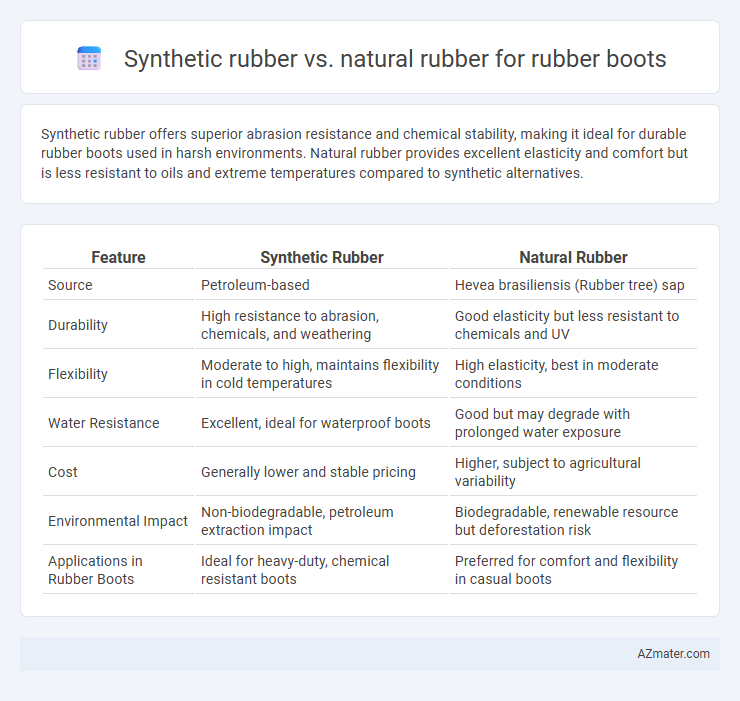Synthetic rubber offers superior abrasion resistance and chemical stability, making it ideal for durable rubber boots used in harsh environments. Natural rubber provides excellent elasticity and comfort but is less resistant to oils and extreme temperatures compared to synthetic alternatives.
Table of Comparison
| Feature | Synthetic Rubber | Natural Rubber |
|---|---|---|
| Source | Petroleum-based | Hevea brasiliensis (Rubber tree) sap |
| Durability | High resistance to abrasion, chemicals, and weathering | Good elasticity but less resistant to chemicals and UV |
| Flexibility | Moderate to high, maintains flexibility in cold temperatures | High elasticity, best in moderate conditions |
| Water Resistance | Excellent, ideal for waterproof boots | Good but may degrade with prolonged water exposure |
| Cost | Generally lower and stable pricing | Higher, subject to agricultural variability |
| Environmental Impact | Non-biodegradable, petroleum extraction impact | Biodegradable, renewable resource but deforestation risk |
| Applications in Rubber Boots | Ideal for heavy-duty, chemical resistant boots | Preferred for comfort and flexibility in casual boots |
Introduction to Rubber Boots: Synthetic vs Natural Rubber
Rubber boots are commonly made from either synthetic rubber or natural rubber, each offering distinct performance characteristics. Synthetic rubber, such as neoprene or styrene-butadiene, provides enhanced resistance to chemicals, oils, and extreme weather conditions, making it ideal for industrial and waterproof applications. Natural rubber, derived from latex sap, excels in elasticity, comfort, and biodegradability but may degrade faster under sunlight and harsh chemicals compared to synthetic alternatives.
Composition and Production of Synthetic Rubber
Synthetic rubber used in rubber boots primarily consists of polymers such as styrene-butadiene rubber (SBR) and nitrile butadiene rubber (NBR), produced through the polymerization of monomers derived from petroleum byproducts. Unlike natural rubber, which is harvested from rubber trees as latex, synthetic rubber is manufactured in controlled chemical processes that allow for consistent quality and tailored properties such as enhanced abrasion resistance and chemical stability. These production methods enable synthetic rubber to outperform natural rubber in demanding environments where durability and oil resistance are critical for rubber boot performance.
Characteristics of Natural Rubber
Natural rubber, derived from the latex of rubber trees, exhibits excellent elasticity, tensile strength, and abrasion resistance, making it ideal for durable rubber boots. Its superior flexibility and resilience provide enhanced comfort and protection against harsh environmental conditions. However, natural rubber is sensitive to temperature variations and can degrade when exposed to oils and chemicals, limiting its use in certain applications compared to synthetic alternatives.
Durability and Longevity Comparison
Synthetic rubber, such as neoprene or nitrile, exhibits superior durability and resistance to abrasion, chemicals, and extreme temperatures compared to natural rubber, making it ideal for heavy-duty rubber boots. Natural rubber, while offering excellent flexibility and comfort, tends to degrade faster when exposed to UV light, ozone, and harsh environmental conditions, leading to reduced longevity. For applications requiring extended wear and resilience, synthetic rubber boots provide enhanced lifespan and consistent performance under demanding conditions.
Waterproofing Performance: Synthetic vs Natural
Synthetic rubber exhibits superior waterproofing performance compared to natural rubber due to its enhanced resistance to water absorption and chemical degradation. Materials like neoprene and nitrile used in synthetic rubber boots offer consistent waterproofing and durability in wet conditions, unlike natural rubber which can deteriorate faster when exposed to prolonged moisture. This makes synthetic rubber the preferred choice for high-performance rubber boots designed for reliable water resistance.
Comfort and Flexibility in Rubber Boots
Synthetic rubber in rubber boots offers enhanced flexibility and consistent comfort due to its engineered molecular structure, which resists cracking and hardening in varying temperatures. Natural rubber provides superior elasticity and a softer feel, adapting well to foot movements and ensuring long-lasting comfort during prolonged wear. Combining both materials can optimize flexibility and cushioning, crucial for durable, comfortable rubber boots in diverse environments.
Environmental Impact and Sustainability
Synthetic rubber, derived from petrochemicals, contributes significantly to carbon emissions and relies on non-renewable resources, raising sustainability concerns for rubber boot production. Natural rubber, sourced from rubber trees, offers a more renewable and biodegradable option but involves challenges such as deforestation and biodiversity loss if not managed sustainably. Implementing responsible harvesting practices and supporting certified natural rubber sources can enhance environmental benefits compared to synthetic alternatives in rubber boot manufacturing.
Cost Analysis: Which Rubber is More Affordable?
Synthetic rubber generally proves more affordable for rubber boots due to its consistent supply and lower production expenses compared to natural rubber, which fluctuates with agricultural conditions and harvest yields. While natural rubber offers superior elasticity and resilience, its price is sensitive to variable factors like climate and labor costs, making synthetic rubber a cost-effective alternative for mass production. Manufacturers prioritize synthetic rubber when budget constraints and scalable production are crucial, balancing performance with affordability.
Common Applications and Use Cases
Synthetic rubber is preferred in rubber boots for industrial and chemical-resistant applications due to its enhanced durability, oil resistance, and weather resilience. Natural rubber is commonly used in agricultural and outdoor boots where flexibility, comfort, and excellent traction on wet surfaces are critical. Both materials serve diverse markets, with synthetic boots dominating heavy-duty work environments and natural rubber favored for everyday, waterproof footwear.
Choosing the Right Rubber Boots: Key Considerations
Synthetic rubber offers enhanced resistance to oils, chemicals, and abrasion, making it ideal for industrial rubber boots requiring durability and protection. Natural rubber provides superior elasticity, comfort, and waterproofing, suitable for outdoor and agricultural boots where flexibility and moisture resistance are essential. Selecting the right rubber boots involves evaluating exposure conditions, desired flexibility, and environmental factors to balance performance and comfort effectively.

Infographic: Synthetic rubber vs Natural rubber for Rubber boot
 azmater.com
azmater.com